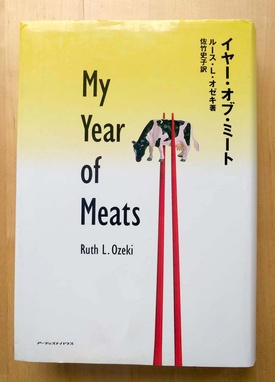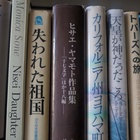Being a Japanese minority in America is a major creative motivation for the novelist, and his work often focuses on his identity as a minority.
The protagonist of Ruth L. Ozeki's debut novel, My Year of Meats (1998), is a Japanese-American television director named Jane Little Takagi. Many Japanese people appear in the story, including Akiko, a Japanese housewife. The story unfolds and exposes the dark side of the meat industry, which is a symbol of American society, and criticizes the excessive commercialism of media such as television and advertising.
This novel was published in Japan in 1999 by Artist House under the title "Year of Meat," translated by Fumiko Satake. It is a lengthy 573 pages.
Ozeki was born in Connecticut in 1956 to an American father and a Japanese mother. He studied at Smith College, earning degrees in English literature and Asian studies, and came to Japan on a scholarship from the Japanese Ministry of Education to study classical Japanese literature. After returning to Japan, he worked on television production and has since earned acclaim for his documentaries.
Her third novel, A Tale for the Time Being, was published in Japan in 2013 by Hayakawa Publishing under the title A Tale for the Time Being (vol. 1 and 2) (translated by Tanaka Fumi). The story begins with a female writer living on an island in Canada discovering a diary written by a junior high school girl from Tokyo in a lunchbox that has washed up on the shores of the island from Japan. She learns that the girl has been bullied and has hinted at suicide. Through the diary, a grand story that transcends time emerges. The world depicted in the relationship between two women, one from Japan and one from the United States, is similar to her first novel.
In "Year of Meat," Jane travels across the United States to produce a documentary to promote American beef to the Japanese market. The show, titled "My American Wife," aims to show Japanese families how various American households enjoy meat dishes.
Ueno, the head of the Japanese advertising agency in charge of planning the show, is hoping for a stereotypical program that portrays America as bright and happy. However, Jane, who has been commissioned to produce the show, senses something false about this intention and wants to create a more valuable documentary that conveys American society.
Jane was motivated to do this as a documentary filmmaker, but she also learned that beef cattle are given hormones during their development, which can have a detrimental effect on the human body. Jane also learned that she herself had been affected by hormones taken by her mother while she was in the womb.
With this awareness of the issues, Jane interviews a gay couple, a family with many adopted children, or a black person, and the food featured in the film is often chicken, offal, or lamb, which is different from the "beef" that the sponsors want to promote. There is something comical about this.
The show is well received by Japanese viewers, but Ueno in Japan is angry at Jane's intentions and demands revisions. Ueno's wife Akiko, who symbolizes the nastiness of commercialism, wants a child, and he accuses Akiko of refusing to conceive, becoming violent towards his wife.
Akiko is portrayed as an obedient housewife, but as she watches the show Jane makes, she begins to empathize with her, and in the end she is inspired by the lifestyle of the American women featured in the show and takes bold action. In this way, Akiko and Jane become closer to Ueno through the show.
The way Jane's independence as a documentary filmmaker and Akiko's independence as a woman are depicted in a non-fiction-like manner that exposes the dark side of the meat industry is thrilling and captivating.
However, the way Ueno and Akiko and other Japanese people are portrayed feels unnatural. This may be because the book is aimed at American readers, but although it is not as bad as Jay Rubin's "Days of the Dead," there is no denying the unnaturalness of the story's adaptation and setting.
For example, when Akiko visits the hospital for infertility treatment, the Japanese doctor in charge tells her that her problem is not physical but psychological, saying, "A twisted wife like you is too much for me to handle." Would anyone have said something like that in the 1990s?
Ueno's use of blatantly foul language to describe black people and his rather rough language towards Jane are also unnatural. The same goes for his verbal exchanges with Akiko.
In his afterword, the translator writes that there had been some criticism in America that the character of Joichi (Ueno) lacked depth, and in response, Ozeki wrote to the translator, "I was asked to pay special attention to how Joichi was portrayed when translating."
(Titles omitted)
© 2017 Ryusuke Kawai







